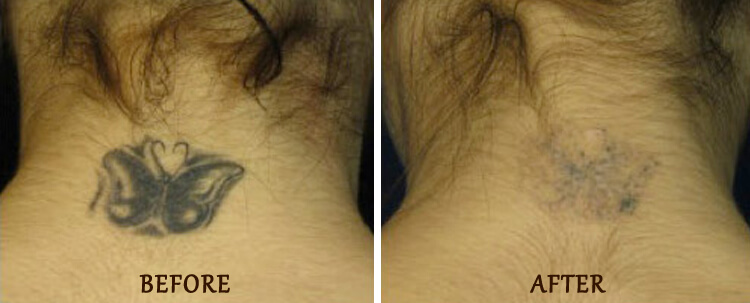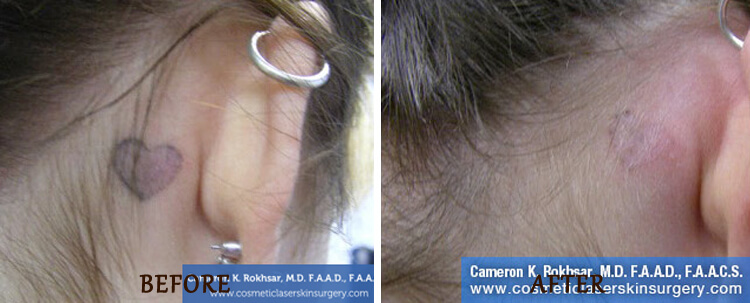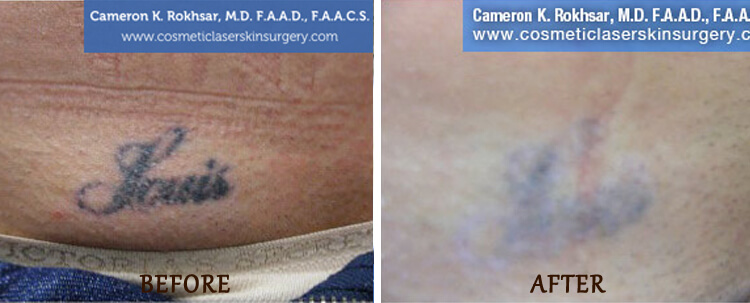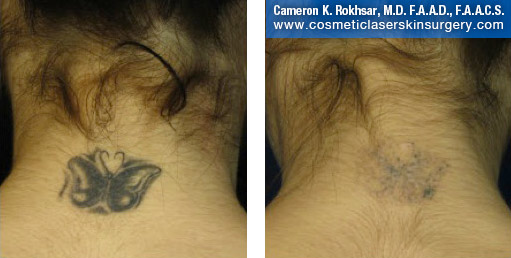Tattoo Removal in New York
As a permanent form of skin art, tattoos have a way of sticking around. But just as with any type of body alteration, we may eventually outgrow the way we feel about our tattoos. In those cases, a tattoo removal procedure may be necessary. Dr. Cameron Rokhsar is among the best laser tattoo removal specialists in New York, in large part due to his familiarity and expertise in laser procedures. Dr. Rokhsar is double board certified in dermatology and cosmetic surgery and is among select few dermatologists in the United States who completed a fellowship in laser surgery. Dr. Rokhsar uses the most advanced lasers at our centers in NYC and Long Island for the most efficient tattoo removal experience. Indeed, most cosmetic surgeons now consider laser tattoo removal1 to be the most effective means of permanently mitigating tattoos.
The Nature of Tattoo Removal
It’s not as though tattoos are something new. This type of body art goes back easily 5,000 years or so. What is new is our ability to effectively and safely remove something that was once permanent. In most cases, Dr. Rokhsar will use what is called a Q-switched laser (in particular, the Q-Switched Alexandrite, or Nd: YAG laser) to break up the pigment particular of the tattoo. As the pigment breaks up, the tattoo gradually clears. Of course, there are many factors which may affect how quickly your tattoo will respond to lasers.
- The depth at which the tattoo artist placed the tattoo ink.
- The color of the tattoo: black, red and green tattoo ink responds much better and faster than red or yellow ink colors.
- The age of the tattoo: old tattoos which are faded, will respond quicker than fresh tattoo which are dark and rich in color.
- The size of the tattoo: Larger tattoos in general may take a greater number of sessions to clear.
- The body area the tattoo was placed: tattoos on ankles for instance are more stubborn to clear and will take a great number of laser sessions.
- Your individual healing process: some people genetically heal better and faster than others.
- Who the tattoo was applied by (a professional vs. amateur, for example): Amateur tattoos will go away faster in response to laser treatments.
- The credentials and experience of your doctor: This is perhaps the most important part of the puzzle. Choose and experienced board-certified laser dermatologist.
Is Tattoo Removal Safe?
Laser tattoo systems, such as the Q-Switched lasers and Pico lasers, have drastically improved the process of tattoo removal. These modern systems have a very low risk of scarring as they remove the pigment by breaking down the tattoo ink into smaller particles allowing the immune cells to pick up and clear the tattoo ink from the area. Additionally, Q-Switched Lasers and Pico lasers work on many pigment types and colors, including blues, greens, purples, and blacks (which previously were difficult to target). This means that a wide variety of new patients now have access to laser tattoo removal procedures2, so even if you were not a good candidate for laser tattoo removal before, you might be now. The best way to find out is to schedule a consultation with Dr. Rokhsar.
Tattoo Removal: Before and After
*Results may vary.
Laser Tattoo Removal Results
At his practice in New York and in Garden City, Dr. Rokhsar has been able to achieve excellent results with his laser tattoo removal treatment. Patients have remarked that they feel better and, sometimes, more authentic after receiving these procedures. In other words, their bodies are now in tune with their identities. That is a very important aspect of laser tattoo removal procedures. It may take several sessions in order to achieve the results you’re after, but you will notice a fading away of your tattoo after each treatment.
As one of the most experienced laser experts in the world, Dr. Rokhsar is among the best resources for laser tattoo removal in New York and Long Island. To schedule an appointment – and to finally get rid of those tattoos – contact our offices to schedule a confidential consultation. You don’t have to live with tattoos you no longer want! Get laser tattoo removal today.
Tattoo Removal Costs
The cost of NYC laser tattoo removal depends on many factors. Such factors include the size of the tattoo, the location of the tattoo, and the colors in the tattoo. Larger tattoos take more time to fade. Tattoos in certain locations (such as the groin, hands, and feet) require more skill and time to treat. In addition, certain colors used in tattoos, especially bright colors, require more skill in order to erase completely. Such colors include red, yellow, and white ink.
Being that sizes of tattoos range from a tiny wrist tattoo to a full back tattoo, a consultation with Dr. Rokhsar is the best way to find out exactly how much your removal will cost. Dr. Rokhsar is a leader in the development and usage of the latest tattoo removal lasers.
Why choose Dr. Rokhsar for your tattoo removal?
Dr. Rokhsar’s laser tattoo removal is PAINLESS, because he uses advanced numbing injection techniques to numb your tattoo prior to the laser treatment. If you have had a painful laser tattoo removal experience, it us because you have chosen the wrong doctor or Med spa. NYC dermatologist and laser specialist, Dr. Rokhsar is an internationally renowned laser surgeon with a particular focus on laser tattoo removal and aesthetic procedures. Dr. Rokhsar is a double board-certified dermatologist and surgeon with years of experience in laser surgery and tattoo removal. He is among very few dermatologists in the country who completed a full one- year fellowship in laser surgery post residency in dermatology. Dr. Rokhsar is a professor of Dermatology at Mount Sinai Hospital in New York City where he teaches the cosmetic dermatology clinic to residents. A graduate of Harvard College and NYU School of Medicine, Dr. Rokhsar has been involved in development and FDA clinical trials for numerous laser systems including the Fraxel laser, Vbeam, Ulthera, miraDry, Thermitight and Pico lasers for tattoo removal. Dr. Rokhsar is simply the best doctor for your laser tattoo removal in Manhattan, Long Island, and Garden City.
Tattoo Removal FAQ
How does laser tattoo removal work?
Dr. Rokhsar has successfully removed thousands of tattoos using the Q-switched laser and Pico lasers. The laser energy targets only the pigmented ink of the tattoo, not the surrounding skin. The laser energy breaks the ink down into tiny particles. The body then naturally ‘digests’ these particles even further. The tattoo will fade and eventually completely disappear. It is very rare that it is impossible to completely remove a tattoo.
Why should I choose Dr. Rokhsar for my tattoo removal?
Dr. Rokhsar has trained thousands of other physicians to use various lasers, including Q-switched lasers and Pico lasers for tattoo removal. Throughout his practice, he has successfully removed thousands of tattoos using Q-switched lasers and Pico lasers. Dr. Rokhsar has notable experience in removing tattoos even in typically difficult cases such as tattoos on dark skin and brightly colored tattoos.
How many treatments will I need?
The number of treatments ranges from 3-12 sessions. Many factors are involved in determining the number of treatments you will need. These factors include the amount of ink used, the depth of the tattoo, the colors in the tattoo, and the color of your skin. Some patients have a noticeable difference after each treatment, while others will only see changes after multiple treatments.
How painful is tattoo removal?
Under the care of Dr. Rokhsar, having a tattoo removed is 100% painless! This is because Dr. Rokhsar will take his time to meticulously numb your tattoo through his advance numbing techniques. Patients experience zero pain or discomfort during the procedure. We can use numbing cream prior to numbing injections as well as a cooling device during treatment. Once numbing injections are administered, your tattoo removal will be pain free. The actual treatment time takes anywhere from 5 to 20 minutes, depending on the size and location of the treatment area.
How should I care for the area after treatment?
After a tattoo removal session in NYC, you may apply cold compresses. The tattoo will have a topical ointment on it and the area will be covered with gauze. You will be given additional ointment and gauze to replace the dressing as needed. It is best to avoi swimming, and excess heat (i.e., saunas, hot showers). Swimming should be avoided for the duration of your treatment sessions. Post-treatment, you can resume your normal activities. If you notice any blisters, do not pick them- this puts you at higher risk for infection and scarring. Never use harsh scrubs or abrasive washcloths on the treatment area. Protecting the treated area from the sun is absolutely necessary- even after the treatment sessions are finished and healing is complete, be sure to wear sunblock on the treated area.
How to remove a permanent tattoo?
Removing a permanent tattoo can be a time commitment as it is done through multiple laser sessions spaced 4-8 weeks apart. The best way to approach tattoo removal, is through advanced q Switched lasers and Pico lasers. Laser removal is one of the most common and effective techniques used for tattoo removal, as it breaks down the ink particles with minimal damage to the surrounding skin. Other options include surgical excision, which involves cutting out the skin that contains the tattoo and stitching the remaining skin together, and dermabrasion, which involves removing the top layer of the skin using a rotating abrasive brush. These two methods are less preferred to laser tattoo removal.
It is highly advisable to consult with Dr. Rokhsar, who has successfully removed thousands of tattoos, to discuss the best options for tattoo removal. Also, some colors, such as white and yellows, are harder to remove than black, blue and green colors. Therefore, it is important to manage expectations and understand that complete removal may not be possible in some cases. Amateur tattoos can typically be removed in 1 or 2 sessions where s professional tattoos may take 3-9 sessions with nano and pico lasers.
How effective is tattoo removal?
Tattoo removal can be effectively achieved through various methods, including laser removal, surgical excision, and dermabrasion. Laser removal is considered the most successful and cost-effective method by most experts. In some instances, it may not completely remove the tattoo, however, it can significantly lighten it. In many instances complete removal is achieved with multiple sessions of a pigment laser performed at 1-2 month intervals. Surgical excision can fully remove the tattooed skin in one session, but it may leave a visible scar and may not work well on larger tattoos. Dermabrasion involves using an abrasive brush on the tattooed skin with a high-speed rotary device. This method is considered to be outdated as it does not work that well and can result in unacceptable scarring of the area.
The success of tattoo removal may depend on various factors, including the size, color, location of the tattoo and intensity and depth of the pigment. Older faded tattoos can be removed with few sessions compared to darker newer tattoos. Laser tattoo removal when performed by an experienced doctor is completely pain free as numbing injections are always administered. When performed at med spas by technicians, Laser tattoo removal is always unbearable and painful, because technicians at medical spas do not maintain licenses to be able to administer numbing injections. In addition, when laser tattoo removal is performed by an experienced laser dermatologist, like Dr. Rokhsar, clearing of the tattoo is achieved much faster because appropriate energy settings can be used safely and pain free after numbing injections.
How many laser sessions for tattoo removal?
The number of laser sessions required for tattoo removal varies depending on several factors such as tattoo size, color, depth and intensity of the tattoo pigment in the skin, and location, as well as the individual’s skin type. The average time between sessions is typically 4 to 6 weeks for best results.
Typically older faded tattoos require fewer laser sessions than fresh darker tattoos. An older faded tattoo may require 1-4 sessions of laser treatment, whereas a new darker tattoo, with lots of ink pigment may require 6-12 sessions of laser treatment. On average, it takes about 3 to 12 sessions to remove a tattoo with laser treatment. However, the number of sessions required can range from as few as 1 to as many as 12 or more. Blue, black, brown and green colors also respond faster compared to orange and red colors. Yellow and white colors remain the toughest tattoos to treat with lasers.
How long does tattoo removal take?
Tattoo removal is a process that takes time and patience, and the length of the process varies depending on several factors. The duration of tattoo removal varies based on the size, color, and ink density of the tattoo, the location of the tattoo on the body, and the age of the tattoo.
Laser tattoo removal is the most common method for removing tattoos. Dr. Rokhsar uses the Alexandrite Q-Switched laser and Pico lasers which are most effective for targeting blue, green, purple, brown or black ink. On average, it takes approximately 3 to 12 sessions for laser treatment to remove a tattoo completely. Complete removal of a tattoo, although possible within 1-2 sessions for an amateur tattoo, often requires more sessions for professional tattoos with deeper colors. The removal session itself takes only a few minutes, depending on the size of the tattoo. The area of the tattoo is numbed with a numbing injection of lidocaine which makes the process completely painless.
The time between treatments will vary based on skin type, ink density, location of the tattoo, and the patient’s timeline for clearance. For laser tattoo removal, it could take between six and 12 sessions before the final results are visible on the skin, although the patient notices further gradual lightening with each progressive treatment. In general, most people can expect to need at least three to eight treatment appointments for optimal removal. Overall, this can mean that the removal treatments can take 12 months or more to complete.
The size of the tattoo also plays a significant role in how long it takes to remove it. A smaller lighter tattoo will be removed in fewer sessions compared to a larger darker tattoo. The number of colors in the tattoo also affects the duration of the process. Your sessions will be longer if there are more colors in your tattoo.
The healing process after each treatment can take up to one to two weeks. While the treated area may appear to be fully healed within about two weeks, the full healing process takes much longer, usually around four to six weeks. The amount of time it takes for the laser tattoo removal process to start fading depends on how the body responds to the treatment, and the kind of ink used is also a major factor. Complete tattoo removal is often possible with the advanced lasers used by Dr. Rokhsar. Dr. Rokhsar may advise to use a few sessions of the Fraxel laser to blend in any discoloration after the tattoo has been completely faded by a q-switched Alex laser or a Pico laser.
How much does laser tattoo removal cost?
The cost of laser tattoo removal can vary depending on several factors such as the size and color of the tattoo, the number of sessions required for complete removal, and the location of the tattoo. A small tattoo may only require a few sessions and will be cheaper, since the process will be less labor intensive, while a larger or more complex tattoo may require more sessions for complete removal. The cost of tattoo removal is not typically covered by insurance.
How to remove bad permanent make-up?
Many people who undergo permanent make-up in the form of permanent make-up on eyebrows, eyeliner permanent makeup or lip liner permanent makeup, either have complications in terms of poor placement of the ink or make-up, or have regrets about it down the road. Oftentimes, the permanent makeup is placed in the wrong area of the eyebrow or the lash lines or corners of the eye. Fortunately, there is a solution to remove permanent make-up. Dr. Rokhsar uses advanced lasers to break up the pigment particles in the poorly placed permanent make up. First numbing injections are administered. If the area involved is around the eye or eyelashes, Dr. Rokhsar will place a shield in your eye to protect your eye from the laser. This is a comfortable process as numbing eye drops are used and the patient feels nothing. A pigment nano-second or pico-second laser is then used to break up the permanent makeup ink particles into smaller particles so that the pigment can get cleared up by the body. Right after the procedure, the permanent makeup area frosts and then forms a scab. The area should be kept moist with some vaseline or aquaphor for a few days to one week until the crusted areas are fully healed. Patients will start noticing improvement in the area of the poorly placed permanent make up within a few wells. Multiple sessions may be required to remove bad permanent makeup in the eyebrows, eyelashes area or eyelid eyeliner area depending on the intensity of the ink used when the permanent make-up was applied. Dr. Cameron Rokhsar with offices in Manhattan and Garden City, New York has treated many patients successfully with permanent make-up gone wrong in the areas of the eyebrows, eyeliner, eyes, eyelashes and lips through laser treatments.
New York Office Locations
Upper East Side Manhattan Office
121 East 60th Street, Suite 8AB New York, NY 10022
(212) 285-1110
Long Island Office
901 Stewart Ave, Suite 240, Garden City, NY 11530
(516) 512-7616
Request an Appointment
References
- Everything You Want to Know About Laser Treatment for Acne Scars. Available: https://www.healthline.com/health/beauty-skin-care/laser-treatment-for-acne-scars.
- Acne Scarring—Pathogenesis, Evaluation, and Treatment Options. Available: https://www.ncbi.nlm.nih.gov/pmc/articles/PMC5749614/.







 Dr. Rokhsar was chosen by
Dr. Rokhsar was chosen by 






